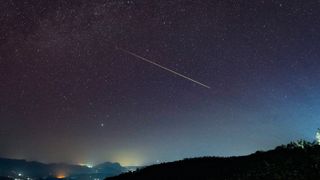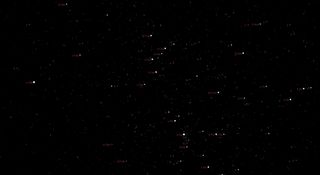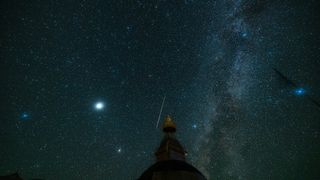Perseid meteor shower 2024 peaks this weekend. Here's how to see summer's best 'shooting stars'

Every August, just when many people go vacationing in the country where skies are dark, the best-known meteor shower makes its appearance: The Perseids.
“This year, the Perseid meteor shower should reach its peak during the overnight hours of late Sunday night into early Monday morning (Aug. 11-12), when there is almost no moon, making the late-night sky nice and dark for shooting star spectators and counters. The first quarter moon sets around 11:20 p.m. local daylight time, leaving the sky nicely dark thereafter. Some Perseids do appear during the evening, but the shower is always better from about 11 p.m. or midnight until the dawn's early light.
Or, to put it another way, expect greater numbers of meteors to be evident during the pre-dawn hours because this is when your side of Earth turns to face the oncoming meteors more directly.
Perseid Meteor Shower in August 2024! NASA's skywatching guide
The Perseid Meteor Shower peaks on Aug, 11-12, 2024. NASA explains where you should look to spot them. Credit: NASA/JPL-Caltech
If you want more advice on how to photograph meteor showers like the Perseids, check out our how to photograph meteors and meteor showers guide and if you need imaging gear, consider our best cameras for astrophotography and best lenses for astrophotography.
Where to look
During those after-midnight hours the shower's radiant point (the point from which it appears to originate), located between the Perseus constellation and the 'W' of Cassiopeia, will be getting progressively higher in the northeast — so meteors should flash across all parts of the sky at a rate of about one every minute or two (as seen by a single observer).
That, anyway, is the prediction if your sky is good and dark. But even if you live under moderate light pollution, as unfortunately, most of us do, you can catch at least the brightest of the Perseids. They have often been described in astronomy journals as including "many bright and fragmenting meteors" that leave persistent trains in their wake.

Earth should go through the thickest part of this "old faithful" of meteor showers for many hours centered around 1400 UTC on Aug. 12, which is 10 a.m. on that date Eastern Daylight Time, which is during the daytime across all of North America. So, for meteor watchers here, the night before and perhaps even after could be equally good. Fortunately, the Perseids stay active — about one-quarter their peak strength — for several days before and a day or two after their peak, and an occasional one may be seen almost anytime during the month of August.
Get the Space.com Newsletter
Breaking space news, the latest updates on rocket launches, skywatching events and more!
A Perseid is one whose path, if traced backward across the sky, intersects a spot between the constellations Perseus and Cassiopeia. Other "sporadic" meteors traveling in random directions occur once every 5 or 10 minutes. Two much weaker showers are also active at this time of the year, the Delta Aquarids and Kappa Cygnids.
Lay back, relax, and wait
You'll need no experience to watch the Perseids. Just find a spot with a wide-open sky view and no late-night lights nearby. Bundle up warmly (it can sometimes get chilly even on summer nights), lie back on a ground pad or in a sleeping bag or even better, on a reclining lawn chair, and watch the stars. Also cover exposed parts of your body with mosquito repellent so you won't get bit.
Be patient, and give your eyes sufficient time to dark adapt. The direction to watch is not necessarily toward Perseus but wherever your sky is darkest, probably straight up.
The Perseids are the ionization trails made by little bits of debris from comet 109/P Swift-Tuttle, streaking into Earth's upper atmosphere at 37 miles (60 km) per second. The Perseids were especially dramatic in the early-to-mid 1990s surrounding the year of Swift-Tuttle's most recent return (in December 1992). Since then, however, they've reverted to normal. The comet isn't due back until August in the year 2126.
Startling occurrences
But surprises can always happen.
On the morning of Aug. 14, 2021, the Perseids displayed an unexpected outburst of meteors between 06:00 and 09:00 UT (2 to 5 a.m. EDT). The cause of this outburst is currently unknown but is probably the result of an unknown filament of comet debris produced by Swift-Tuttle as it raced through the inner solar system many centuries ago.
In an announcement on Central Bureau for Astronomical Telegrams Circular #5016, the maximum zenithal hourly rate was estimated to be somewhere between 130 and 210, plus or minus 20. Amazing numbers considering that rates are normally 50% lower each preceding night after maximum but these rates are two to three times more than was seen during the expected maximum on the night of Aug. 12-13, 2021.
Four years from now "might" bring a truly amazing Perseid display, as some meteor experts are predicting that Earth will interact with a thick knot or clump of meteoric material shed by comet Swift-Tuttle during the 15th century, that possibly could produce a short-lived display of many hundreds of meteors per hour.

Defying predictions
Sometimes, even in years that are deemed favorable for Perseid viewing, sky watchers report seeing only a half or a third as many meteors that were predicted — and yet others report up to twice as many! It has been suggested that the stream of Perseid particles, strung out along its orbit around the sun, has a complex filamentary structure with gaps and rich spots.
Complicating the situation is the fact that some people's eyes seem better suited for meteor work than others.
Regardless of your local viewing circumstances, each year the appearance of the Perseids give many people a reason to head outside and gaze upward at the night sky. Even if you see only a few "shooting stars," all it takes is catching sight of one outstandingly bright meteor to make the viewing experience worthwhile.
A final incentive is to note that next year the moon will be at a waning gibbous phase only a few days past full and will flood the sky with bright light, squelching all but the brightest Perseid streaks. So, take advantage of the favorable conditions provided to us this year.
To one and all we wish good luck and clear skies!
Joe Rao serves as an instructor and guest lecturer at New York's Hayden Planetarium. He writes about astronomy for Natural History magazine, the Farmers' Almanac and other publications.
Join our Space Forums to keep talking space on the latest missions, night sky and more! And if you have a news tip, correction or comment, let us know at: community@space.com.“
No comments:
Post a Comment
Note: Only a member of this blog may post a comment.